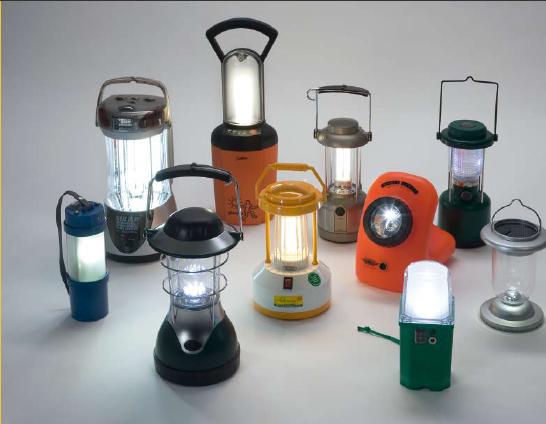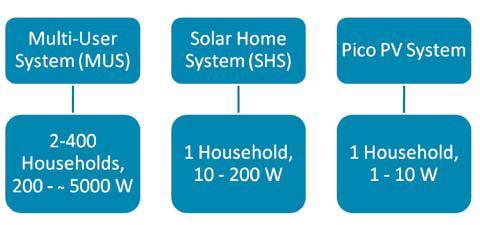Difference between revisions of "Features of PicoPV Systems"
***** (***** | *****) |
***** (***** | *****) |
||
| Line 1: | Line 1: | ||
| − | + | [[Image:PicoPV Solarleuchten.JPG]] | |
| + | |||
| + | (Source: Solarleuchtentest: Licht und Schatten, 2009) | ||
| + | |||
| + | == Features == | ||
| + | |||
| + | PV off-grid systems are mainly defined through power dimension and the number of users (Mitja et al., 2003). All systems include one or more solar modules of different sizes and various appliances. Frequently used categories are multiuser systems (MUSs), solar home systems (SHSs) and the very small PicoPV systems. | ||
| | ||
| Line 23: | Line 29: | ||
*[[Lamps and Electric Appliances|lamp]] | *[[Lamps and Electric Appliances|lamp]] | ||
| − | A PicoPV system can be equipped with various lighting technologies. '''Compact fluorescent lamps (CFL) '''are based on the same functional principle as standard fluorescent lamps, but are more energy efficient than the latter as they work at a higher internal pressure, are smaller and have a higher illuminating power. At present the [[Lighting Technologies|'''light emitting diode (LED) '''technology seems]] to be the most forward-looking option. Although this light source still lacks behind the light output of energy-efficient CFL, LED lamps consume less energy, while their quality standards are improving at a fast pace. Both CFL and LED bulbs outperform by far the traditional lighting technologies based on kerosene, biomass, diesel, propane and wax (used by 14% of urban households and 49% of rural households in the developing world IEA 2002 cited in Mills 2005), in terms of output of lumen per watt. | + | A PicoPV system can be equipped with various lighting technologies. '''Compact fluorescent lamps (CFL) '''are based on the same functional principle as standard fluorescent lamps, but are more energy efficient than the latter as they work at a higher internal pressure, are smaller and have a higher illuminating power. At present the [[Lighting Technologies|'''light emitting diode (LED) '''technology seems]] to be the most forward-looking option. Although this light source still lacks behind the light output of energy-efficient CFL, LED lamps consume less energy, while their quality standards are improving at a fast pace. Both CFL and LED bulbs outperform by far the traditional lighting technologies based on kerosene, biomass, diesel, propane and wax (used by 14% of urban households and 49% of rural households in the developing world IEA 2002 cited in Mills 2005), in terms of output of lumen per watt. |
| | ||
| Line 35: | Line 41: | ||
Many models of PicoPV systems also allow for the operation of other small electric devices such as a ''small radio, small loudspeakers'', or a ''MP3-player''. In general, the size of the module and the storage capacity of the battery determine the range of electric appliances which can be connected to the system. If required even a ''small TV'' or a ''little fridge'' can be operated. One example is the seven inch solar LCD Colour TV of Free Energy Europe which consumes less than 10 W per hour. In addition, various standard plugs USB-ports are also on the rise. They facilitate the operation of a huge range of small USB-devices like for example small fans. | Many models of PicoPV systems also allow for the operation of other small electric devices such as a ''small radio, small loudspeakers'', or a ''MP3-player''. In general, the size of the module and the storage capacity of the battery determine the range of electric appliances which can be connected to the system. If required even a ''small TV'' or a ''little fridge'' can be operated. One example is the seven inch solar LCD Colour TV of Free Energy Europe which consumes less than 10 W per hour. In addition, various standard plugs USB-ports are also on the rise. They facilitate the operation of a huge range of small USB-devices like for example small fans. | ||
| − | | + | [[Image:Main_SPL_Technology_Options.JPG]] |
| + | |||
| + | <ref>2010. Lighting Africa. Solar Lighting for the Base of the Pyramid - Overview of an Emerging Market</ref> | ||
| − | Mainly, the use of PicoPV systems allows the substitution of traditional light sources like inefficient and relatively dark kerosene lamps. <ref>2010. GTZ.What difference can a PicoPV system make? Early findings on small Photovoltaic systems - an emerging lowcost energy technology for developing countries</ref> | + | Mainly, the use of PicoPV systems allows the substitution of traditional light sources like inefficient and relatively dark kerosene lamps. <ref>2010. GTZ.What difference can a PicoPV system make? Early findings on small Photovoltaic systems - an emerging lowcost energy technology for developing countries</ref> |
<br> | <br> | ||
| − | | + | == Typology == |
| + | |||
| + | The industry today lacks a common set of definitions or terminology, with solar lanterns being too generic a term to properly define the spectrum of products available. Lighting Africa forecast the following styles of products to become increasingly differentiated in the future:<br> | ||
| + | |||
| + | *'''Flashlights/Torches '''- portable handheld devices offering directional lighting at low lumen output. Today’s solar torches typically feature integrated solar panels. | ||
| + | |||
| + | *'''Task lamps/work lights '''– portable or stationary handheld devices, including solar desk lamps, in a range of panel sizes and light output levels utilized for specific tasks (i.e. reading, weaving etc.). | ||
| + | |||
| + | *'''Ambient lamps /“lanterns”''' – portable or stationary devices that resemble the kerosene hurricane lamp form factor. They typically offer multi-directional light along with a wide variety of size and functionality depending on technology (e.g., from heavy, powerful CFL lanterns to smaller LED-based systems). | ||
| + | |||
| + | *'''Multi-functional devices '''– portable or stationary devices that can provide directional and multi directional light, a variety of value-added features (i.e. mobile phone recharge), and can be utilized for either task based or ambient lighting needs. | ||
| − | + | *'''Micro-SHS '''– semi-portable lighting devices associated with a small portable solar panel that powers or charges 1-3 small lights, mobile phones, and other low-power accessories (e.g., radio, mini-fan).<ref>2010. Lighting Africa. Solar Lighting for the Base of the Pyramid - Overview of an Emerging Market</ref><br> | |
| − | + | [[Image:Solar_Portable_Lights.JPG]] | |
| + | | ||
| + | | ||
<references /> | <references /> | ||
[[Category:PicoPV]] | [[Category:PicoPV]] | ||
Revision as of 12:33, 16 November 2010
(Source: Solarleuchtentest: Licht und Schatten, 2009)
Features
PV off-grid systems are mainly defined through power dimension and the number of users (Mitja et al., 2003). All systems include one or more solar modules of different sizes and various appliances. Frequently used categories are multiuser systems (MUSs), solar home systems (SHSs) and the very small PicoPV systems.
PicoPV systems are small independent appliances providing light and/or additional small electrical services, such as radios, mobile phone charging, mp3 player, etc.
A PicoPV system mainly consists of three components:
The PV panels for the lights are mostly made of polycrystalline- or mono-crystalline silicon. The nameplate power ranges from 0.3 Wp for a solar lantern with an integrated panel up to 12 Wp for the combined system. The majority of the systems are equipped with panels from 1 to 3 Wp.
There are different types of batteries used in the systems,lead-acid and NiMH batteries being the most common
types, while Li-Ion batteries are presently used only in few cases.
A PicoPV system can be equipped with various lighting technologies. Compact fluorescent lamps (CFL) are based on the same functional principle as standard fluorescent lamps, but are more energy efficient than the latter as they work at a higher internal pressure, are smaller and have a higher illuminating power. At present the light emitting diode (LED) technology seems to be the most forward-looking option. Although this light source still lacks behind the light output of energy-efficient CFL, LED lamps consume less energy, while their quality standards are improving at a fast pace. Both CFL and LED bulbs outperform by far the traditional lighting technologies based on kerosene, biomass, diesel, propane and wax (used by 14% of urban households and 49% of rural households in the developing world IEA 2002 cited in Mills 2005), in terms of output of lumen per watt.
An increasing number of mature PicoPV systems provide additional energy services through various appliances which can be integrated in a multipurpose system or connected as external devices through a plug:
- ICT Appliances
The presently most common and popular appliance is a mobile phone charger which is either connected to the main device (the lamp) through a cable for charging from the battery, or directly to the module. These systems usually come with a set of different phone charging pins intended to cover a range of the most widely spread mobile phone types.
Many models of PicoPV systems also allow for the operation of other small electric devices such as a small radio, small loudspeakers, or a MP3-player. In general, the size of the module and the storage capacity of the battery determine the range of electric appliances which can be connected to the system. If required even a small TV or a little fridge can be operated. One example is the seven inch solar LCD Colour TV of Free Energy Europe which consumes less than 10 W per hour. In addition, various standard plugs USB-ports are also on the rise. They facilitate the operation of a huge range of small USB-devices like for example small fans.
File:Main SPL Technology Options.JPG
Mainly, the use of PicoPV systems allows the substitution of traditional light sources like inefficient and relatively dark kerosene lamps. [2]
Typology
The industry today lacks a common set of definitions or terminology, with solar lanterns being too generic a term to properly define the spectrum of products available. Lighting Africa forecast the following styles of products to become increasingly differentiated in the future:
- Flashlights/Torches - portable handheld devices offering directional lighting at low lumen output. Today’s solar torches typically feature integrated solar panels.
- Task lamps/work lights – portable or stationary handheld devices, including solar desk lamps, in a range of panel sizes and light output levels utilized for specific tasks (i.e. reading, weaving etc.).
- Ambient lamps /“lanterns” – portable or stationary devices that resemble the kerosene hurricane lamp form factor. They typically offer multi-directional light along with a wide variety of size and functionality depending on technology (e.g., from heavy, powerful CFL lanterns to smaller LED-based systems).
- Multi-functional devices – portable or stationary devices that can provide directional and multi directional light, a variety of value-added features (i.e. mobile phone recharge), and can be utilized for either task based or ambient lighting needs.
- Micro-SHS – semi-portable lighting devices associated with a small portable solar panel that powers or charges 1-3 small lights, mobile phones, and other low-power accessories (e.g., radio, mini-fan).[3]
File:Solar Portable Lights.JPG
- ↑ 2010. Lighting Africa. Solar Lighting for the Base of the Pyramid - Overview of an Emerging Market
- ↑ 2010. GTZ.What difference can a PicoPV system make? Early findings on small Photovoltaic systems - an emerging lowcost energy technology for developing countries
- ↑ 2010. Lighting Africa. Solar Lighting for the Base of the Pyramid - Overview of an Emerging Market





















